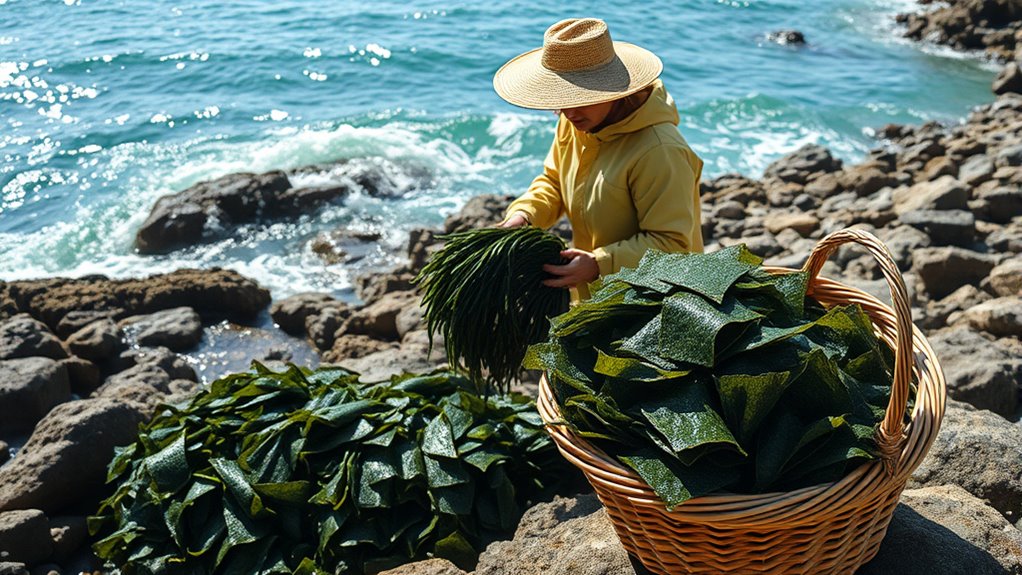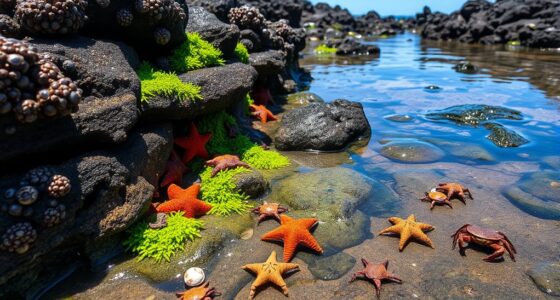To safely gather wild nori sheets, visit coastal shorelines during late spring or early summer at low tide when seaweed is easiest to access. Use scissors or your hands to gently pluck only what’s needed, avoiding uprooting or damaging the patches. Be mindful not to trample fragile beds or leave waste behind. Following sustainable practices helps protect marine ecosystems while providing fresh nori quickly. Keep exploring how you can harvest responsibly for healthy oceans and delicious sushi.
Key Takeaways
- Harvest nori during optimal seasons like late spring or early summer using low tide and calm weather for safety and freshness.
- Use scissors or hands to gently pluck sheets, avoiding uprooting or damaging the seaweed roots.
- Follow local regulations and avoid stripping entire patches, taking only what is needed to promote regeneration.
- Minimize environmental impact by not trampling seaweed beds, carrying a container, and rinsing harvested nori with seawater.
- Support ocean health by practicing sustainable harvesting, understanding ecosystem importance, and contributing to marine conservation efforts.

Gathering wild nori sheets is a rewarding activity that connects you with nature’s bounty. As you venture to the shoreline, you’re not just collecting a tasty sea vegetable—you’re participating in a practice that can support sustainable harvesting and promote ocean conservation. Wild nori thrives in healthy marine environments, and by harvesting responsibly, you help guarantee these ecosystems remain vibrant for future generations. It’s essential to approach this activity with respect for nature’s balance, making sure your collection methods do not damage the delicate marine habitat.
Harvest wild nori responsibly to support ocean health and preserve marine ecosystems for future generations.
When you gather wild nori, always prioritize sustainable harvesting techniques. Avoid stripping entire patches of seaweed; instead, take only what you need, leaving enough behind to allow the plants to regenerate. Use scissors or your hands to gently pluck the sheets, ensuring you don’t uproot or disturb the roots of the seaweed. This careful approach supports the ongoing health of the marine environment and helps maintain the biodiversity of local ecosystems. Respect local guidelines and regulations, as many coastal areas have specific rules in place designed to protect ocean life and promote responsible harvesting.
Timing is also vital when gathering wild nori. The best season typically aligns with the peak growth period, often during late spring or early summer, when the seaweed is lush and abundant. Harvesting during this window not only yields the freshest, most flavorful sheets but also minimizes stress on the population. Be mindful of tides and weather conditions; low tide provides easier access, and calm weather makes the activity safer and more enjoyable.
As you collect the sheets, be conscious of your impact on the environment. Avoid trampling over fragile seaweed beds or leaving behind waste. Instead, carry a small container or a mesh bag to store your harvest, ensuring the sheets stay clean and prevent any loose debris from polluting the ocean. After gathering, rinse the nori sheets with seawater or clean water to remove sand and impurities, preparing them for drying or culinary use. Additionally, understanding ocean conservation can enhance your awareness of responsible harvesting practices and help protect these vital ecosystems.
Frequently Asked Questions
Can I Harvest Nori During the Rainy Season?
You can harvest nori during the rainy season, but you should be cautious of environmental impact. Rainy season harvesting may increase risks of overharvesting or damaging the delicate ecosystem. It’s essential to follow sustainable practices, like limiting your collection and avoiding overharvesting, to protect the environment. Be mindful of local regulations and seasonal guidelines to make sure your nori gathering remains eco-friendly and responsible during this wet season.
What Tools Are Best for Collecting Wild Nori?
For collecting wild nori, you’ll want to use handheld tools like sturdy scissors or a small knife to carefully cut the sheets without damaging the seaweed. A collection basket or mesh bag is ideal for gathering and transporting your harvest efficiently. These tools help you harvest quickly and safely, ensuring you preserve the quality of the nori while making the process simple and manageable.
How Do I Identify Edible Nori From Other Seaweed?
Think of seaweed identification like spotting a friend in a crowd—look for specific features. Edible nori has dark green to black color, a tender texture, and a mild aroma. Avoid seaweeds with bright colors, slimy surfaces, or unpleasant smells, which often indicate toxicity. Always verify with local guides or reliable resources to distinguish edible from toxic seaweed, ensuring your harvest is safe and delicious.
Are There Legal Restrictions on Harvesting Wild Nori?
You should check local regulations before harvesting wild nori because there are often legal restrictions. Many areas require harvesting permits to guarantee sustainable practices and protect marine ecosystems. Conservation laws aim to prevent overharvesting and maintain healthy seaweed populations. Always verify with local authorities or environmental agencies to stay compliant, and follow guidelines to preserve the environment while gathering nori responsibly.
How Do I Store Harvested Nori to Keep It Fresh?
To keep your harvested nori fresh, store it properly with these storage tips. First, rinse the sheets gently to remove salt and debris, then pat them dry. Keep the nori in an airtight container or resealable bag to preserve freshness and prevent moisture exposure. Store it in a cool, dark place or in the refrigerator. Proper storage helps maintain flavor, texture, and shelf life, ensuring your nori stays crisp and delicious.
Conclusion
As you carefully gather those wild nori sheets, it’s almost surreal how nature’s bounty aligns with your hands, making this simple act feel like a lucky coincidence. Just when you thought you’d need endless hours or luck, the sea’s gifts appear effortlessly. With each sheet, you realize that sometimes, the best moments happen when you least expect them—reminding you that a little chance and a lot of patience can turn a quick harvest into a memorable experience.










